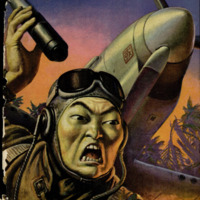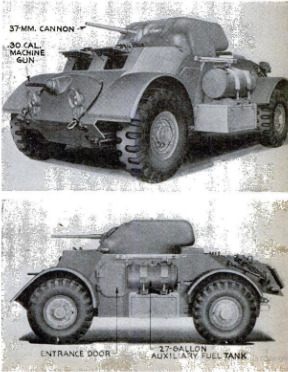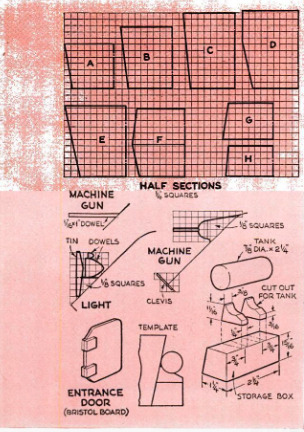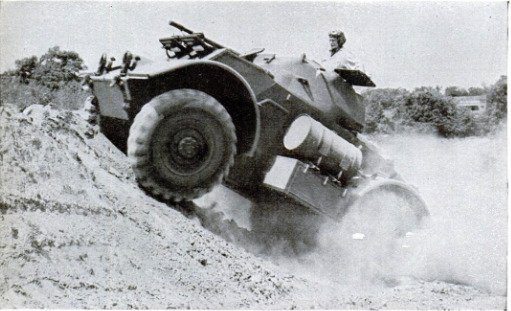Scale model of the british staghound
Item
-
Title (Dublin Core)
-
Scale model of the british staghound
-
Article Title and/or Image Caption (Dublin Core)
-
Scale model of the british staghound
-
extracted text (Extract Text)
-
ONE day last fall a group of British
infantrymen was lying alongside a
road near a small Dutch city. The Nazis
had a machine-gun nest up ahead. Every
time a Tommy stuck his head up, puffs of
dust raised by murderous enemy bullets
came marching across the road toward him.
Usually when an infantry unit is pinned
down in this manner, it dispatches a patrol
to attempt to wipe out the nest—exceeding-
ly dangerous work under the best of condi-
tions. But the British commander had a
better idea. He turned to a portable radio
and spoke briefly into it.
In a few minutes an odd-looking vehicle
rolled up at a speed comparable to that of
a passenger car. Its angular, squat body
was set on four tremendous wheels—each
almost 4 in diameter—and surmounted by
a turret from which protruded a cannon
and a machine gun. Pausing just long
enough to gets its bearings, it swept onward.
The German gun chattered like an angry
squirrel and a hail of bullets clanged in-
effectively against the heavily armor-plated
body. In reply, the car began spitting
tracers from the turret-mounted machine
gun. The white-hot barbs moved about a
bit as the gunner adjusted his aim; then
pumped steadily into the enemy position.
The gunner pushed a button and the cannon
—which had been moving automatically as
the machine gun moved—boomed mightily.
The Nazi emplacement disappeared in a
Dail of debris.
So ended an episode in the thrilling story
that the formidable American-built Stag-
hounds are writing. Made by Chevrolet, the
Staghound—a high speed combination tank
and reconnaissance car with four-wheel
drive—was first produced in 1942, but only
recently has it been taken off the secret list.
It weighs 14 tons and carries a five-man
crew. Two auxiliary fuel tanks give it an
extensive cruising range. Armament and
equipment include the 37-mm. cannon with
its tracer-firing machine gun, two-way
radio, a .30-cal. machine gun, a submachine
gun, ‘hand grenades, a Steering-and-gun-
sighting periscope for use when the hatches
are shut, an intercommunication phone, a
fire-extinguisher system, and a searchlight
with a flasher attachment for signaling.
Besides eliminating machine-gun nests,
the Staghound can wipe out any type of
light-weapon emplacement, locate and blast
groups of snipers, augment infantry attacks,
menace enemy supply lines, patrol occupied
areas, and lay protective smoke screens.
The model is made from Bristol board,
close-grained wood such as white pine, and
paper-clip wire. Lay out a grid of 1/4
squares on a piece of cardboard; by match-
ing squares, tranfer the half sections to this
piece; then cut away the excess material
to form templates. Using these as guides,
carve the body from a solid block of wood.
Drill two holes through the block at the
indicated points to take 1/2 by 4 9/16" dowel
axles. Drive the axles into place and secure
them with glue.
Using the screw center on your lathe,
turn four wheels. Fasten them fo the axles
with 2” wood screws and 1/16" by 1/2 dia.
‘washers. Lay the apron out on a piece of
Bristol board and cut it to size. Score and
bend it as indicated and glue it to the body.
The over-all width, from outside edge to
outside edge of each pair of Bristol-board
fenders, is 6 5/8”. Bend the front fenders
to a radius of 1 5/8” and sand down the
apron at the points where the fenders cross
it. The radius to which the back fenders are
bent is 2”. Shape the inner edge of all four
fenders to fit the body and glue in place.
Carve the turret from a block of wood
and fasten it to the body with two screws
located so they will be hidden by the turret-
top hatches, which are made of Bristol
board and glued to the turret. The blister
and the cannon foundation are made from
scraps of wood and glued to the turret face.
The cannon is shaped from a 1/4” dowel.
The storage boxes, tank foundations, and
tanks are made from wood; the machine
guns are 1/16" dowels; and the hatches,
entrance doors, and rear-deck deflector are
Bristol board. The front lights are carved
from dowels, set on scrap-wood foundations,
and protected by tin guards. The taillights
are made by splitting a dowel into two
pieces and shaping each piece; each light is
glued to a Bristol-board foundation and each
foundation is glued to the body. The ex-
haust silencers are lengths of 1/4 doweling
and have wire lead-in pipes. Make the
assist handles and clevises from paper-clip
wire.
Finish the completed model with brownish-
gray camouflage paint.
-
Contributor (Dublin Core)
-
John G. Kingdon (Article Writer)
-
Language (Dublin Core)
-
eng
-
Date Issued (Dublin Core)
-
1945-01
-
pages (Bibliographic Ontology)
-
150-152
-
Rights (Dublin Core)
-
Public Domain
-
References (Dublin Core)
-
M-8
-
Archived by (Dublin Core)
-
Sami Akbiyik
-
Marco Bortolami (editor)
 Popular Science Monthly, v. 146, n. 1, 1945
Popular Science Monthly, v. 146, n. 1, 1945






